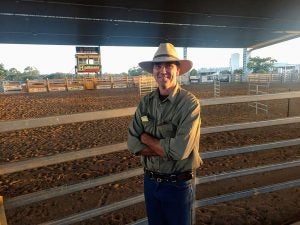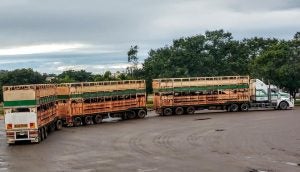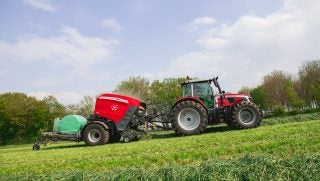I just got back from speaking at the Northern Beef Producers Expo in Charters Towers, Queensland, Australia, where I was able to learn more about Aussie beef production firsthand. One thing that really piqued my interest was the better understanding of how cattle farmers (also known as “graziers,” what we call ranchers) manage extreme weather conditions like flooding and drought.
Michael “Mick” Duckett was one of those graziers. He lives and farms on Caerphilly Station, named after second-largest castle in Great Britain. This station (called a “ranch” by U.S. standards) is 1.5 hours south of Charters Towers and consists of around 3,500 head of Belmont Red cattle on 120,000 acres — the total includes adult cows, yearlings and heifers, and younger weaned heifers. These cattle need a fair amount of time for maturity for breeding and go about pregnancy in a natural way, where predators and weather can certainly have an impact. With a cattle herd inclusive of 30 very happy bulls, Mick does pregnancy testing on his cows and shoots for 1,200 to 1,500 calves each year and aims to wean calves at around 150 kilos (to help the Americans reading this, that’s about 330 pounds).

After weaning, the second step is transporting the castrated makes (steers) to Amatunga station. Amatunga is a growing and finishing property (called a block) that consists of 9,300 acres near Capella Queensland. The heifers are kept for replacement heifers to go back into the breeding herd. After the steers reach 360 to 400 kilos, Mick will then sell them to feedlots (if the prices are good enough) for grain finishing.

What if the price of beef is not good to sell? He then can keep and finish the steers to 550 kilos (called a bullock) and sell direct to an abattoir (aka slaughterhouse). As an accredited grasslands producer, he can sell to Teys Australia (market slaughter) and receive a premium since they’re grass finished. (He believes grass fed has a better taste.)
One question any good grazier has to ask themselves though is: Do they have enough grass to feed out their cattle? One animal can eat 20 to 30 kilos (44 to 66 pounds) of dry matter per day or more, which means they need anywhere between 8 and 25 acres per head, depending on the region and conditions. In his area, Mick aims to finish 1,200 steers in a good seasons, and the simple math and proper management helps to work out the stocking rate as a rough estimate. Depending on rainfall, it can take two to three seasons to finish out a steer for market.
What if there’s not enough grass? In many parts of Queensland (a state that is over twice the size of Texas) they’ve been in drought for over six years. Despite the fact that it can be tough, Mick explains they’re used to it in his area and speaks as a true optimistic grazier: “Love your grass more than your cows” and “regret the sale but not the price.” When he had to sell over 50 percent of breeder cows, he looked for opportunities to turn low value cattle into high value very quickly and tracks his costs using Quickbooks or Phoenix programs.
Is the price of grain cheap? Is there demand for fat cattle? What does it take to produce a kilogram of beef? Focus on that cost of production. He explains how important it is to have good working relationships with local sale barns, feed lots, cattle buyers, and auctioneers. Sell wherever you can! In this “word of mouth” community they have a good amount of options and also do online research through cattlesales.com.au to find the best solution.
Despite the fact that cattle graziers pride themselves on their knowledge of land and animal holistic management and sustainability, sometimes things become extreme to a point where it’s a sense of emergency. You may have heard about the fact that hundreds of thousands of cattle were lost in horrific flooding after a long, extreme drought earlier this year. An area that normally receives 9 inches of rain for the entire year instead received 48 inches of rain in only two days. People were evacuated or rescued via helicopter, and no matter how well their herds were managed, unfortunately there was not much they could do. A very unfortunate circumstance from our raging queen Mother Nature.
When interviewing Mick, his sense of pride and farm management is contagious and clear. Do the right thing, manage your drought conditions, know when to sell. If circumstances are tough but not quite this extreme, he isn’t a fan of the “woe is me” attitude. Put your head down, get to work, do what needs to be done, and calmly deal with the situation. If you react early, you can preserve your core herd and manage your way through it.
“There’s always someone worse off; we’ll get through it,” he says.
Spoken like a true farmer, an optimist.
“Stop thinking what if, start thinking what now.”
Michelle Miller, the Farm Babe, is an Iowa-based farmer, public speaker, and writer, who lives and works with her boyfriend on their farm, which consists of row crops, beef cattle, and sheep. She believes education is key in bridging the gap between farmers and consumers.



